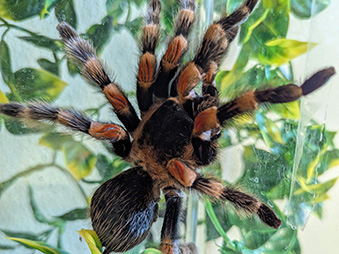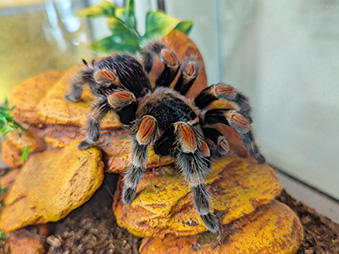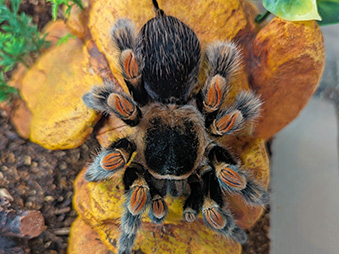Brachypelma hamorii | Mexican red-knee tarantula
Name: Rosa (Female)



Meet Rosa: Our Red-knee Tarantula
Say hello to Rosa, our beautiful and mysterious red-knee tarantula! With her striking red-orange leg markings, Rosa represents one of Mexico’s most iconic—and often misunderstood—arachnids.
A Desert-Dwelling Beauty
Native to Mexico’s central Pacific coast, red-knee tarantulas thrive in dry scrublands, deserts, thorn forests, and tropical deciduous forests. These environments provide plenty of burrows and leaf litter, perfect for a nocturnal hunter like Rosa to hide during the day and emerge at night.
Despite their fearsome appearance, red-knee tarantulas are actually quite shy. Instead of relying on vision (they have eight eyes, but poor eyesight), they use sensitive hairs on their legs to detect vibrations, smells, and even chemical cues in the environment. These sensory adaptations help them locate prey, sense danger, and communicate with other tarantulas.
Life and Diet
In the wild, red-knee tarantulas are ambush predators. They wait near their burrow entrances, having prepared a sensitive web mat that picks up the vibrations of passing prey. When something like a large insect, small frog, or mouse steps on the mat, Rosa knows it’s time to strike—leaping forward to inject venom with her fangs.
Her venom is effective at paralyzing and liquefying the prey’s insides, which she then consumes using straw-like mouthparts located just behind her fangs. This feeding process is both efficient and fascinating.
Tarantulas are slow to grow but can live incredibly long lives. Males typically live up to 10 years, while females like Rosa can live 25–30 years with proper care, making them among the longest-living arachnids!
Unique Defenses
Though rarely aggressive, tarantulas will defend themselves if they feel threatened. One of their primary defense mechanisms is flicking urticating hairs from their abdomen using their hind legs. These tiny, barbed hairs can irritate skin and eyes—and even cause temporary blindness in predators.
If that doesn’t work, they may rear up to display their fangs in a classic warning pose. It’s a powerful reminder that even small creatures have impressive survival strategies.
Rosa’s Role in Education
While Rosa currently resides behind the scenes, she plays an important role as an ambassador animal. Through educational programs, she helps us teach others about the value and beauty of arachnids. Often misunderstood or feared, tarantulas like Rosa are crucial for controlling insect populations and maintaining healthy ecosystems.
Keeping Wild Animals Wild
Due to their unique appearance and docile nature, red-knee tarantulas have become popular in the exotic pet trade. However, they are not ideal pets for most people. Despite their size, they are delicate, shy, and require specific care and habitats to thrive. Their venom, while mild (comparable to a wasp sting), and urticating hairs can still pose problems—especially for people with sensitivities.
Sadly, many tarantulas end up in rescues when owners realize too late that they weren’t prepared for the responsibility. That’s why it’s best to appreciate these incredible creatures in zoos or educational settings. Learn more through the Not-a-Pet campaign, which highlights why wild animals like Rosa belong in the wild—or with professionals.
Fact Sheet
Taxonomy
Species: Brachypelma hamorii
Kingdom: Animalia | Phylum: Arthropoda | Class: Arachnida | Order: Araneae | Family: Theraphosidae | Genus: Brachypelma |
Favorite Enrichment Type
Items to attach her web to and hide in!
Life Span
- Males: 5 to 10 years
- Females: 25 to 30 Years
Diet
- In the Wild: Large insects, frogs and mice.
- At the Zoo: Crickets, roaches
Geographic Range
Central Pacific coast of Mexico.
Habitat
Scrubland, deserts, dry thorn forests, or tropical deciduous forests.
Cool Facts
- Nighttime is Feeding Time! Mexican red-knee tarantulas are nocturnal, which means they like to come out and party… at night! While we’re sleeping, they’re on the prowl.
- Hair Today, Gone Tomorrow: When they feel threatened, these clever spiders kick tiny, barbed hairs—called urticating hairs—off their abdomen. These hairs can make your skin itchy and your eyes really uncomfortable… some predators even go temporarily blind! Yikes!
- Yes, They’re Venomous—But Don’t Panic! Red-knee tarantulas do have venom, and a bite might hurt (like a wasp sting), but it’s not dangerous to humans. They’d honestly rather run away than bite you.
- Stealthy Snack Attackers: These spiders are ambush predators! They lay out special web “welcome mats" near their burrows that help detect vibrations. When dinner (like a bug or small critter) walks by—POUNCE! Dinner is served.
- Fierce Looks, Shy Hearts: They might look like little monsters, but red-knee tarantulas are actually pretty shy. If given the choice, they’d rather hide than fight!
Status: Vulnerable
Conservation and Awareness
Although common in the pet trade, Mexican red-knee tarantulas are now listed as Vulnerable. Wild populations are declining due to habitat loss from urbanization and agriculture, and unsustainable collection for the exotic pet market.
By learning about and sharing stories like Rosa’s, we can help raise awareness, promote conservation, decrease the collection of her wild counterparts, and protect their native habitats for generations to come.
How to Find Me
Rosa is a member of our Ambassador Animals that lives behind the scenes! If you would like to meet Rosa in person, check out our daily, 11:00am Amphitheater Presentations at the Awareness Amphitheater, located just beyond the covered bridge. Amphitheater Presentations are dependent on the weather. Please check our activity board, behind the Admissions booth, before coming to see us!
